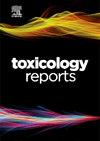Understanding the impact of triazoles on female fertility and embryo development: Mechanisms and implications
Q1 Environmental Science
引用次数: 0
Abstract
Triazoles are among the most widely used fungicides that were launched in 1980s and are one of the most important pesticide groups used in agriculture as plant growth regulators and stress protectors. Triazoles are also frequently used in the pharmaceutical industry to treat fungal and bacterial infections as well as to treat and prevent some forms of pneumonia. Humans are normally exposed to triazoles through food, water, and medications, which raises concerns about their potential adverse effects on health. Therefore, this review was planned to examine the impact of triazole fungicides on female fertility, as well as their teratogenic and embryotoxic effects. Various search engines such as PubMed, Google Scholar, Elsevier, IEEE were used to search the relevant articles published between 2006 and 2024 using the following keywords: "azoles," "female infertility," "reproductive toxicity," "teratogenicity," "triazoles," and "embryo toxicity." The findings suggest that triazoles might negatively affect female fertility and embryonic development through multiple mechanisms including inhibition or interference with key enzymes such as CYP17A1 and CYP19A1 (aromatase) involved in steroid hormone synthesis, endocrine disruption, oxidative stress, disruption of signaling pathways, and apoptosis. This review consolidates current knowledge on the teratogenic and embryotoxic properties of triazole fungicides, providing a comprehensive understanding of their health implications and addressing critical research gaps.
了解三唑类药物对女性生育能力和胚胎发育的影响:机制和意义
三氮唑是20世纪80年代推出的最广泛使用的杀菌剂之一,是农业中用作植物生长调节剂和应激保护剂的最重要的农药组之一。三唑类药物也经常用于制药行业,用于治疗真菌和细菌感染,以及治疗和预防某些形式的肺炎。人类通常通过食物、水和药物接触三唑,这引起了人们对它们对健康的潜在不利影响的担忧。因此,本文拟对三唑类杀菌剂对女性生育能力的影响及其致畸和胚胎毒性进行综述。使用PubMed、b谷歌Scholar、Elsevier、IEEE等各种搜索引擎搜索2006年至2024年间发表的相关文章,使用以下关键词:“唑类”、“女性不孕症”、“生殖毒性”、“致畸性”、“三唑类”和“胚胎毒性”。研究结果表明,三唑类药物可能通过抑制或干扰参与类固醇激素合成的关键酶CYP17A1和CYP19A1(芳香化酶)、内分泌干扰、氧化应激、信号通路破坏和细胞凋亡等多种机制对女性生育和胚胎发育产生负面影响。这篇综述整合了目前关于三唑类杀菌剂致畸和胚胎毒性的知识,提供了对其健康影响的全面理解,并解决了关键的研究空白。
本文章由计算机程序翻译,如有差异,请以英文原文为准。
求助全文
约1分钟内获得全文
求助全文
来源期刊

Toxicology Reports
Environmental Science-Health, Toxicology and Mutagenesis
CiteScore
7.60
自引率
0.00%
发文量
228
审稿时长
11 weeks
 求助内容:
求助内容: 应助结果提醒方式:
应助结果提醒方式:


